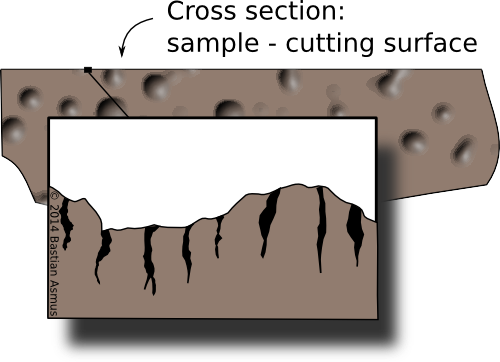how to do slag microscopy – sample cutting

This shows a cross section through a sample. On a micro-scale the cutting surface of a samples is shattered by the cutting process. This areas needs to be removed for samples to be representative of the find.
This is part two of the series on slag microscopy and will deal with sample cutting. Part one was on the macroscopic description and documentation of the sample. Of course these steps may equally employed to mount samples other than slag.
The following things are needed for this:
- a circular diamond blade cutter / tile cutter
- ultrasonic bath
- IMS
- safety goggles
- ear protection
- lab coat or an apron
Sample cutters
Make sure you were appropriate personal safety gear. The diamond blade cutter is probably the most important piece of lab equipment. It allows you to cut your finds into manageable pieces. There are two kinds of sample cutters around: one with fast turning diamond blades and one with low speed discs. Low speed discs can be much thinner, produce thin cuts and smoother machined surfaces. With up to 20 minutes per cut they are too slow if you have to cut more than one sample. For most finds the fast turning machines offer good results, so this is what we are going to use. Sample cutting with such a machine comes with a few problems as well:

Sample grinder and circular diamond blade. A simple perspex cover ensures you stay dry during the cutting process (:
the material immediately next to the sample will have suffered mechanically, i.e. it will show micro-shattering. These stress fractures need grinding off to produce unblemished and representative sample areas. This is especially true for heterogeneous, hard and brittle materials.
Cutting the sample to size
These discs run at high speeds and need water for cooling and lubrication. Make sure you are protected from water and flying bits of offcut. For example you can place a perspex cover on top of your saw and – for a change – stay dry during the cutting process.
Although it is not strictly necessary to cut the find at all, for example if you have access to an inverted microscope. It is, however, a sensible thing to prepare polished sections, because these can be analysed with tools other than the microscope, too. It is customary that samples are mounted in resin in 32 or 25 mm diameter plastic sample cups, but there are also other shapes and diameters as well. Samples are cut down to a size so we can place them into the sample cups. While you are at it, cut the sample in a way that the side facing downwards in the cup is flat and even, because this is the face to be polished. This will save valuable time when it comes to grinding.
Sample cleaning
Samples need to cleaned before mounting, because there might be a lot of swarf in the pores. These are detrimental to chemical analyses which might take place at a later stage. It may also simply confuse you, when you try to identify this material. Depending on the condition of your sample use a brush and running water, then place the sample in an ultrasonic bath. Often it is enough to use warm soapy water. No need for expensive cleaning agents. Use small petri dishes for different solvents and place them inside the water within the ultrasonic bath. Afterwards you may use IMS, subsequently also acetone to get rid of grease. This will also facilitate the drying process. After the samples are dry they can be mounted in resin.
Recap
- use the diamond saw to cut the sample according to your sample cup
- if you need to make samples for other analytical methods such as for example XRF: prepare them now while you are at it
- clean samples thoroughly, e.g. in an ultrasonic bath, get rid of the swarf
- use small petri dishes with soapy water to remove water soluble dirt
- use small petri dish IMS for diluting water residues, as well as for degreasing and to allow for faster drying
- leave them to dry properly






January 21st, 2014 at 13:23
[…] i.a. samples are mounted in resin. I have talked about the find documentation process and the cutting of the sample in parts one and […]
February 21st, 2014 at 21:51
[…] reached part seven part of the slag microscopy course. After sample prep, with find documentation, cutting, mounting, grinding, lapping and polishing we are now going to have a look at the tool to be used […]